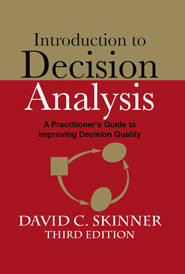 In the opening pages of Introduction to Decision Analysis, decision analyst David Skinner tells the harrowing story of "the hardest decision [he] ever made":
In the opening pages of Introduction to Decision Analysis, decision analyst David Skinner tells the harrowing story of "the hardest decision [he] ever made":
In September of 1998, I was working... in Venezuela when I received a phone call from a good friend that my wife... was in the hospital...
I quickly called the hospital, and after several minute of arguing with the front desk, I was put through to my wife's doctor in the Emergency Room. The doctor informed me that my wife was having a massive stroke and that her prospects were not good. I asked about her immediate condition and what course of treatment they were proposing. He informed me that the MRI scan indicated about 40% of the right side of her brain was affected by the stroke and she was completely paralyzed on her left side.
...[The doctors] told me that given the amount of the brain affected, they did not know if she would live through the night. Often in these cases, the brain swells uncontrollably, crushes the brain stem... and you die. This is what would have happened without some sort of intervention.
As luck (providence?) would have it, my wife was brought to a teaching hospital with a world famous stroke team that was trying a new experimental therapy. In this new therapy, they cool the body down to put it into a hypothermic state. They hoped that this would give the body time to adjust to the trauma and help prevent further brain swelling. I asked about the success rate for this treatment, and the answer was not compelling. The doctor said, "She will be the fourth person in the world to receive this treatment protocol." When prompted about the other three patients, he replied that two had died from complications and one was severely paralyzed. This was not what I wanted to hear! I must admit that by now the shock was stating to set in and I was not doing well.
The other available treatment was to perform a craniotomy where they remove a portion of the skullcap to allow the brain to expand outside the skull. This did not sound like a great alternative either! At this point, I was shocked, confused, and concerned about my wife's treatment options. [Unfortunately] the treatment decision had to be made immediately. Time was of the essence.
I began to interview the doctor about the two treatment options. I needed more information about the probability of success, further complications, and the likely resulting quality of life. From experience, I knew that doctors are not always good at representing the probability of success for treatments so I began exploring the factors that contributed to the deaths and paralysis of the other three patients. I discovered that two of the patients had died from pneumonia as a complication from the hypothermic state. All three of the previous patients were considerably older than my wife and had other health problems. My wife was in extremely good health and actually had the stroke while teaching an aerobics class. The doctor did not feel that the other patients were a good indicator of my wife's situation.
Even though my wife was in good health, there was still a reasonable chance that this treatment would not work and could create additional life threatening complications. As I worked through these assessments with the doctor, I was able to construct a decision tree of the options... and develop an understanding of the various associated outcomes. Then I assessed the probability of occurrence for each of the outcomes and made my decision. The analysis showed a greater chance for a high quality of life coming from the hypothermic treatment. That is what I chose. Without the structured approach to decision making and the careful consideration of the various options and outcomes, I would not have had the clarity of action and would probably have chosen the craniotomy treatment.
It is now ten years later and I am happy to tell you that she is doing very well and has a good quality of life... And, in October 2004, my wife and I had our first child, Makenzie Elizabeth.
Medical decisions can be among the most important decisions we ever make, and unfortunately Mr. Skinner is right that doctors often fail to reason correctly about probabilities. Hence the importance of the judgment and decision-making skills (aka "rationality skills") that Mr. Skinner used to save his wife's life — and that CFAR is dedicated to teaching.
Further reading:
Casscells et al. (1978). Interpretation by physicians of clinical laboratory results. New England Journal of Medicine 299: 999-1001.
Eddy (1982). Probabilistic reasoning in clinical medicine: Problems and opportunities. In Kahneman et al. (eds.), Judgment under Uncertainty: Heuristics and Biases. Cambridge University Press.
Skinner (2009). Introduction to Decision Analysis, 3rd edition. Probabilistic Publishing.


